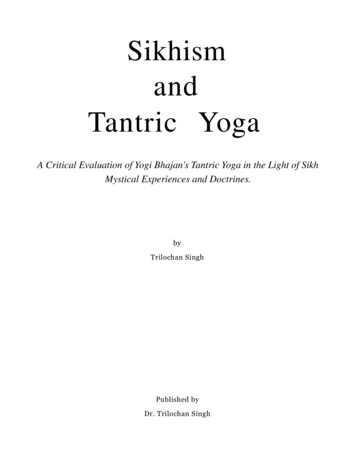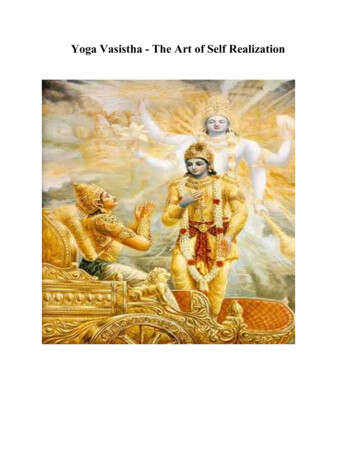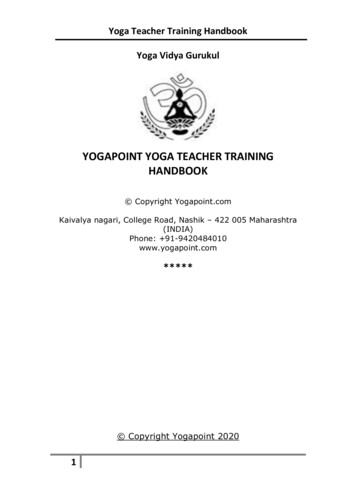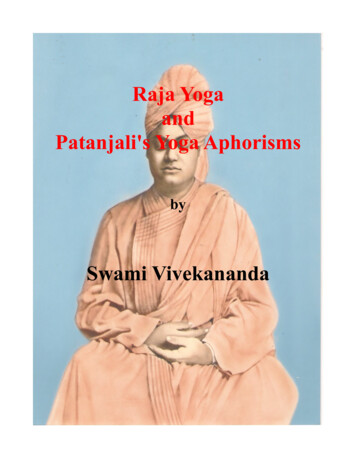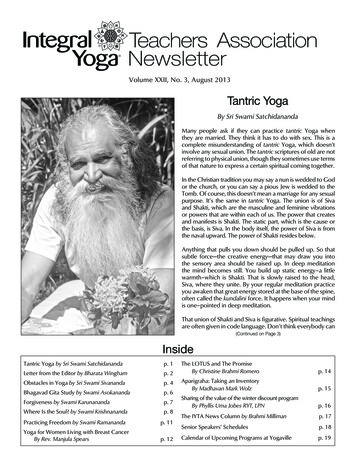
Transcription
Volume XXII, No. 3, August 2013Tantric YogaBy Sri Swami SatchidanandaMany people ask if they can practice tantric Yoga whenthey are married. They think it has to do with sex. This is acomplete misunderstanding of tantric Yoga, which doesn’tinvolve any sexual union. The tantric scriptures of old are notreferring to physical union, though they sometimes use termsof that nature to express a certain spiritual coming together.In the Christian tradition you may say a nun is wedded to Godor the church, or you can say a pious Jew is wedded to theTomb. Of course, this doesn’t mean a marriage for any sexualpurpose. It’s the same in tantric Yoga. The union is of Sivaand Shakti, which are the masculine and feminine vibrationsor powers that are within each of us. The power that createsand manifests is Shakti. The static part, which is the cause orthe basis, is Siva. In the body itself, the power of Siva is fromthe naval upward. The power of Shakti resides below.Anything that pulls you down should be pulled up. So thatsubtle force—the creative energy—that may draw you intothe sensory area should be raised up. In deep meditationthe mind becomes still. You build up static energy–a littlewarmth–which is Shakti. That is slowly raised to the head,Siva, where they unite. By your regular meditation practiceyou awaken that great energy stored at the base of the spine,often called the kundalini force. It happens when your mindis one–pointed in deep meditation.That union of Shakti and Siva is figurative. Spiritual teachingsare often given in code language. Don’t think everybody can(Continued on Page 3)InsideTantric Yoga by Sri Swami Satchidanandap. 1Letter from the Editor by Bharata Winghamp. 2Obstacles in Yoga by Sri Swami Sivanandap. 4Bhagavad Gita Study by Swami Asokanandap. 6Forgiveness by Swami Karunanandap. 7Where Is the Soul? by Swami Krishnanandap. 8Practicing Freedom by Swami Ramanandap. 11Yoga for Women Living with Breast CancerBy Rev. Manjula Spearsp. 12The LOTUS and The PromiseBy Christine Brahmi Romerop. 14Aparigraha: Taking an InventoryBy Madhavan Mark Wolzp. 15Sharing of the value of the winter discount programBy Phyllis Uma Jobes RYT, LPNp. 16The IYTA News Column by Brahmi Millimanp. 17Senior Speakers’ Schedulesp. 18Calendar of Upcoming Programs at Yogavillep. 19
The Goal ofIntegral YogaIntegral YogaTeachers AssociationThe goal of Integral Yoga, and the birthright of everyindividual is to realize the spiritual unity behind all thediversities in the entire creation and to live harmoniously asmembers of one universal family.The Integral Yoga Teachers Association is a membershipassociation open to all Integral Yoga teachers. Its mission isto provide mutual support and spiritual fellowship, to shareinformation, to provide inspiration, and to conduct ongoingtraining and guidance.This goal is achieved by maintaining our natural conditionof a body of optimum health and strength, senses undertotal control, a mind well-disciplined, clear and calm, anintellect as sharp as a razor, a will as strong and pliable assteel, a heart full of unconditional love and compassion,an ego as pure as a crystal, and a life filled with SupremePeace and Joy.Attain this through asanas, pranayama, chanting ofHoly Names, self-discipline, selfless action, mantra japa,meditation, study and reflection.Om Shanti, Shanti, Shanti.Ever yours in Yoga, Director:Newsletter Editor:Graphic Design:Photos:Gopal WatkinsBharata WinghamAnand Shiva HervéMadhavan AubertArchivesCopy Editors: Lilavati Eberle, Jeff Curry,Brahmi Milliman, Lakshmi FradianniMembership Coordinator: Brahmi MillimanIntegral Yoga Teachers AssociationSatchidananda Ashram–Yogaville108 Yogaville Way, Buckingham, VA 23921 USATel: 434.969.3121, ext. 177 Fax: 434.969.1303E-mail (Newsletter): iytanewsletter108@gmail.comE-mail (Membership): membership@iyta.orgE-mail (Director): gopal@iyta.org Website: www.iyta.orgFrom The EditorNamaste! Welcome to this issue of the IYTA Newsletter. Thereis a lot of excitement at the Ashram about our new SivanandaHall expansion project. It will offer increased seating capacityas the stage area is being expanded and the hall will bepartitioned off for meals and other separate activities.We begin with Sri Swami Satchidananda giving us a correctunderstanding of Tantric Yoga. In recent years this subjecthas been a topic of much misunderstanding and misuse, andit is good to have a proper attitude and approach to it.This quote from His To Know Your Self seems to sum up theentire Tantric goal as well as a caution, “Here the tantric orspiritual union is described as the union of the female aspectwith the male aspect or Shakti with Siva. That language caneasily be misunderstood as referring to physical union.”An exciting event took place at Yogaville earlier this year. Thearticle LOTUS and the Promise by Christine Brahmi Romero,describes a special interfaith program and the Interfaith workof LOTUS Center for All Faiths (LCAF). Swami Dayanandahosted a group of esteemed presenters, including Dr. SayyidSyeed, the National Director and head of the Office ofInterfaith & Community Alliances in Washington, DC.Sri Swami Sivananda discusses a major topic of the searchfor spiritual enlightenment, Moha.It, “is one of the greatest obstacles for the spiritual aspirants and is the root cause for human sufferings.” He offers usIYTA Newsletter August 2013 Page 2some funny examples and insightful waysto counter-act the attachments in our livesthat lead to suffering and hindrances to ourspiritual growth.Swami Asokanada is sharing his insights from years ofstudying and applying the Bhagavad Gita in his life. He sharesthe method of removing grief from our life, na anusocitum(there is no cause for grief).Swami Karunananda writes about Forgiveness. She discussesboth sides of the forgiveness equation and the effects of nonforgiveness, and provides us with three exercises to help inhealing our grievances.And in case you have misplaced your Soul somewhereSwami Krishnananda tells you where and how to find itMadhavan Mark Wolz uses the Hatha Yoga Sun Salutationseries of poses to walk us through the Yogic principle ofAparigraha, non-greed.Phyllis Uma Jobes shares a personal and uplifting experienceof organizing a group of her students as a part of thewinter discount program available for IYTA members andtheir students.We hope you enjoy this issue of the Newsletter.Om Shanti, Bharata
(Continued from Page 1)read the Bible and understand it. Ancient scriptures all havethat esoteric or inner meaning. Here the tantric or spiritualunion is described as the union of the female aspect with themale aspect or Shakti with Siva. That language can easily bemisunderstood as referring to physical union.Some people take advantage of the language in the tantricscriptures, “I’m going to teach you tantric Yoga,” they say.“Come sleep with me.” With a heavy heart I tell you that someso–called gurus do this, and to them I say, “If you want to havesex, be open about it. Do as you like, but don’t bring in thescriptures pretending to be teaching something.” Even devilscan quote scriptures. There’s a great deal of misunderstandingabout these things. If you come across a tantric Yoga bookyou may read of the offering of madya which is wine or liquor.Some will say, “You are my goddess; I am the god. Let us offermadya. Drink, then have sex.” This is not the drink that is meantin the teachings. The madya are certain hormones within.Precisely, they are the subtle psychic hormones producedby the pituitary and pineal glands, and the force behind andaround them. When that kundalini or creative force rises up, itbrings warmth to those glands, and they secrete this hormonewhich no doctor has ever seen in test tubes. That hormone iscalled madya, the nectar you taste when Siva and Shakti arejoined in union. You become exhilarated. You are spirituallyintoxicated by that nectar.Unfortunately, this has all been misinterpreted on a worldlylevel. Some people are “teaching” tantric Yoga. But this veryunion will happen in your regular meditation. Tantric union willhappen during any deep meditation at the point when youhave kept your mind still for a considerable amount of time.It can be proven scientifically. When the body is completelymotionless, you will feel warmth. Because there’s nowastage, the energy becomes static, just like the warmth ofthe current you feel in a condenser. You can feel a battery’swarmth because there is current which isn’t flowing, butis stored. During meditation you store all your prana, yourvital energy, in the body. There’s no mental movement, nodisturbing thoughts arising in the mind, so even that smallamount of energy is saved. This builds the static energy thatcreates warmth.When you go deep into meditation for such an experience,your body must also be capable of bearing it. Otherwise itwill burst, as when you try to store too much current in aweak condenser. This is why the body must be built up withYoga practices.So, build a pure, strong, and flexible body. Then develop thisforce in you. Let it build up through your deep meditation.Rouse the static power to go through the spine and ascendto the skull. That is the meru, the Himalayas, the height, theheavens. This is the moment you taste the nectar of spiritualunion and are intoxicated by that great experience.—Excerpt from To Know Your SelfThe year 2014 marks the special occasion of the Centennial of Sri Gurudev’s birth, and weare planning celebrations from December 22, 2013 - December 22, 2014. Please join IntegralYoga International in creating a GLOBAL GARLAND of commemorative events to honor SriGurudev. Plans are in the works for special events at all our centers around the world. In thefall issue of the IYTA Newsletter we’ll share detailed information and ideas about how you canget involved. In the mean time you can visit GlOBAL GARLAND on Facebook to find out more.IYTA Newsletter August 2013 Page 3
Obstacles in YogaBy Sri Swami SivanandaMoha–AttachmentMoha is one of the greatest obstacles for the spiritual aspirants.Moha is infatuated love for one’s own body, wife, children,father, mother, brothers, sisters and property. Mind alwaysgets attached to one form or other. When it is taken fromone form, it clings to another form. No one is free from somekind of attachment. Aaskti (attachment), kamana (longing),raga (attraction) and preference to certain things are thevarious methods by which this great power moha binds thejiva to the samsara-chakra. A man is attached to rice. He has alonging for eating rice when he has given up rice on accountof his diabetes. This is kamana. If rice and bread are served, aBengali or a Madrasi will certainly have a preference for rice.This also you should give up if you want to destroy moha.Moha is the greatest weapon of maya. Mysterious is maya.Mysterious is moha. Moha is a kind of powerful liquor thatbrings intoxication in the twinkling of an eye.You would have never come into this world, had it not beenfor the influence of moha. The first attachment starts withthis physical body. Then all other attachments crop up. Thencomes the relationship of father, mother, brother, sister,wife, son, etc. One may have attachment to a place, personor object. Wherever there is attachment, there is the idea ofmamata (mineness). Attachment is a sort of very strong gluethat binds the mind with the sensual objects. Why does themind get attached to objects or persons? Because it findspleasure in them. Wherever there is pleasure, the mind getsattached there.Attachment is the root cause for human sufferings. It is theproduct of avidya. It is a modification of nescience. Thehusband weeps on the death of his wife, because he isattached to the physical body of his wife. The wife weepson the death of her husband, not because of pure love forhim, but because she can no longer get sexual pleasure andother comforts which she had when he was alive. Infatuatedlove, delusion and fear are the old-standing associates ofattachment. The cause of fear is the attachment to thisphysical body and property. Attachment and fear areinseparable. They are like fire and heat.You are not at all affected when one says: “That house is onfire. The horse is dead.” Because there is neither attachmentnor identification here. But if one says: “The house of Mr.Ramnarayan is on fire; The horse of Ganga Shankar is dead”at once the hearts of these people are affected since theyhave identification or attachment with the house or horse.It is this kind of attachment that brings sorrow.Paramahamsa sannyasins always wander about. Theyshould not stay for more than three days in a place. Themain object in this discipline is to cut off attachment. Bylong stay in one place, raga and dvesha will graduallydevelop. Real renunciation consists in renouncing the idea:IYTA Newsletter August 2013 Page 4‘I am the body.’ Real renunciation consists in abandoningthe attachment for this body. “Sarva sanga parityaga–Giving up all sorts of attachments” is the key for attainingthe bliss of Atman. It does not mean that one should retireinto the forest. Sikhidhvaja still had attachment to his bodyand Kamandalu though he lived in the forest, whereas hiswife Queen Chudala was absolutely free from any sort ofattachment even though she ruled a dominion.Thousands of widows from Bengal and Madras are stayingin Benares with the idea that they will get mukti if they diein Benares. But their minds are fixed on their grandchildren.They are attached to the huge bundles of cow-dung cakeswhich they have accumulated in the backyard of theirhouses for starting a fire. Some people are attached to paltrythings such as notebooks, books, walking sticks, picturesand small handkerchiefs. The friendship of several yearscomes to a termination if Mr. Rajan fails to return a smallbook which he borrowed from Seshu. Fighting ensues. Itbegins with a showering of hot words and abuses. They donot talk and see each other from that moment. Ladies fightfor little things, as they have a great attachment for meagerthings also.In Madras, a boy was accidently drowned in a tank. Hismother who was nearby and who had an intense attachmentto her only son immediately jumped into the tank anddrowned herself. Her husband was very much attached tohis wife and child. He also jumped and drowned himself.Instances like these daily occur in various parts of the world.Several people become nervous and get shocks when theylose the things to which they are attached very much. Suchis the havoc done by the power of attachment. If a manreceives a telegram that his only son is dead, he gets ashock and faints. Some people immediately die when theyhear such news.Look at the moha of monkeys. If the baby monkey dies, themother-monkey will carry the dead body for one or twomonths even. Such is the great power of moha. Cows havegreat moha for their calves.Moha will not spare even sannyasins who have renouncedeverything. Moha troubled even Sri Sankara. He had toattend the sick bed and funeral of his mother, though hewas a sannyasin. The great saint Pattinathuswami says atthe funeral of his mother: “There was at first fire at Tripura:then at Lanka (Ceylon). Now there is fire in my stomachcaused by the death of my mother. Let me also apply fire tothis corpse of my mother.” Sannyasins get slowly attachedto their Ashrams and disciples. This is more difficult foreradication. This attachment is stronger than the attachmentof worldly persons. Many are attached to their Kamandalusand sticks and small tumblers. Even at the time of death theyentertain thoughts of petty articles. The mind is so framedthat it sticks to the old ruts and grooves. It demands drastic
and rigorous discipline and sadhana to get rid of all sortsof’ attachment. One has to struggle hard to destroy Moha.It is moha that brings us again to this mrityu-loka. The seedof attachment is ingrained in the subconscious mind. Themind tries its level best to get attached to some form orother. It cannot remain without clinging to one form. Itleaves one form and immediately clings to another form.This is its svabhava. This is due to the quality of Rajas. If Rajasis eradicated, all attachments will die by themselves. Oneshould always be on the alert to detect the subtle workingsof moha. Moha creates delusion and perverted intellect.Through the force of maya, you mistake the unreal, dirtybody for the real, pure Atman. You take the unreal worldas a solid reality. These are the functions of moha. Younever wept when millions died in the Great War. But youweep bitterly when your wife is dead. Why? Because youhave moha for her. Moha creates the idea of “mineness.”Therefore you say: “My wife. My son. My horse. My house.”This is bondage. This is death.You will have to train your mind daily in all dealings andactions. Do not get attached to your wife, children andproperty. The world is like a public inn. People are unitedfor some time and they are separated in a short time. Turnthe mind towards God and do daily japa and meditation.Study books on Vedanta and Bhartrihari Vairagya Satakam.The seeds of moha are ingrained in the subconscious mind.You have to obliterate or fry up all these seeds throughright thinking and vichara. You will have to cut all theseillusory attachments through the sword of vairagya (nonattachment). Gita says: “Asangasastrena dridhena chittva—Cut this tree of maya with the sword of non-attachment.”Develop internal vairagya by understanding the illusorynature of this world. Remember the pains of this samsara,birth, death, old age, disease and miseries of this world.Place before the mind the glorious life in Atman and theimmense bliss of a spiritual life. Remember the saints, sagesand yogins. Get inspiration from them.Learn to discriminate between the real and the unreal. Haveno intimate connection with anybody. Lead a life of non–attachment in this world. The man who has no attachmentto this world is the most happy man. He is God Himself. Donot bother a bit when you lose little things. Think alwaysthat the perishable objects are worthless. Repeat theformulas mentally several times: “All objects are vishtavat(like dung). All objects are vishavat (like poison).” You candestroy moha if you mentally repeat in all circumstances:“Even this will pass away.”Moha brings manifold miseries, bondage, discord andrupture. Moha is your dreadful enemy. It is real death. Non–attachment raises you to Godhead, lifts you up to the loftyheights of Brahman. Non–attachment brings unalloyedbliss, eternal life, freedom, independence, perfection,concord and harmony.Moha is the greatest of all obstacles. All other obstacles inthe practice of Yoga emanate from this moha. If you cangradually destroy this, then the whole spiritual sadhana andSelf-realization is very, very easy. We can even say thatthe whole spiritual sadhana is intended for destroying thisdreadful enemy.—Excerpt from Practice of YogaIYTA Newsletter August 2013 Page 5
Bhagavad Gita StudyCommentary by Swami AsokanandaChapter 2 Verse 24: The Self cannot be pierced or cut; itcannot be burned, moistened or dried. It is endless, allpervading, stable, immovable and everlastingbeyond the perception of the senses—but“inconceivable” (achintya)—that is, beyondthe mind’s comprehension.Chapter 2 Verse 25: It is said to be unmanifested,inconceivable and immutable. Knowing all this, there is nocause to grieve.Anything beyond thought is necessarily beyond words. ButKrishna is using a bunch of words to describe That whichis indescribable. He is trying to help us get some sense ofSomething that can only be grasped through one’s ownexperience. And that experience can only come to us whenthe “I” has been purified enough to slip out of the clutchesof body/mind identification.Sri Gurudev: “We lose sight of our being Atman and thinkconstantly of becoming That.”Sri Ramakrishna: “What is Brahman like? It cannot be definedwith words.”The True Self (Atman) is everlasting, all-pervading, neverchanging, never-moving, and timeless. It is unmanifestedand inconceivable. Knowing this, there is no cause to grieve.It is good for us to recognize what is possible for the mindto understand and what is not possible for the mind tounderstand. Arjuna can get some conceptual grasp that theTrue Self is a subtle Consciousness that cannot be destroyed.In the second sentence, though, Sri Krishna wants to makeit clear that the Atman is not only “unmanifested”—that is,IYTA Newsletter August 2013 Page 6As long as our feeling of “I” is associated with our instruments(the body and mind), we are bound to experience fear,anxiety, discomfort as we navigate through our lives as bestwe can. We will have thoughts like: “I ate too much. I’mstuffed. I’m getting fat.” “So-and-so is really bumming me out.How can he not see that I am right and he’s wrong?” The real“I,” the ultimate Subject, is the Pure Awareness witnessingwhat’s taking place—maybe with some compassion andamusement.Through meditating on these two verses, we can get a tasteof na anusocitum—that there is no cause for grief.
ForgivenessBy Swami KarunanandaThere’s a saying, “To err is human, toforgive is divine.” Mahatma Gandhi wasonce asked how he could put up withall the injustice and cruelty in the world. He responded,“I’m such a scoundrel myself, I have compassion for allthe other scoundrels in the world.” When we considerour own weaknesses and mistakes, and how hard it is forus to change, shouldn’t we be more compassionate andforgiving to others? Sri Gurudev used to say that whenwe point a finger of accusation at someone else, thereare three fingers pointing back at us, and there’s one, thethumb, standing up— like God—witnessing everything.Sri Patanjali in the Yoga Sutras speaks of tapas, whichmeans accepting pain as help for purification. All theannoyances and difficulties, injustices and ordeals, makeus strong. We are like gold being purified. The problemschip way at the dross in our personalities so that the truegold in us, our divine image, can shine forth. A saintlyperson once described it this way: “There are two typesof people in the world: the saints and the saint-makers.” Inother words, there are those who are sent to inspire us, andthose who come to purify us. So, the next time you startto get annoyed at someone who pushes all your buttons,thank them instead for showing you your weaknesses andhelping you to grow stronger.The Tirukkural advises: “At all times put up with theexcesses of others; to forget them at once is even better.”You may ask, “How is it possible to forget when someonehas wronged you?” There’s a story about a spiritual teacher,who, as a boy, had a classmate that treated him very cruelly.Years later, the former classmate came to visit the teacher,where he was received with much kindness. After a while,he asked the teacher, “Don’t you remember how badlyI treated you when we were boys?” The teacher gentlyreplied, “I distinctly remember forgetting it!”Forgiveness is an act of choice. It is not about denying,condoning, or excusing hurtful actions. Rather, it is theletting go of resentment or revenge, even when they seemwarranted, and offering instead mercy and love. By sodoing, we release the past and let go of negative thoughtsand feelings. We become unstuck and can move on in ourlives. Energy that was tied up within us becomes availablefor positive, creative endeavors. Relationships are healed,and we, too, are healed.Forgiveness and healing are linked. In speaking offorgiveness, the Holy Bible says: “Forgive us our trespassesas we forgive those who trespass against us.” When weforgive others, the spirit of forgiveness flows through us,and we, too, receive the benefit. It’s like using a funnelto transfer honey from one vessel to another: the funnelalso gets the sweetness. We transfer the honey of divineforgiveness to another, and we, too, are forgiven.I once met a woman who, twenty years prior, had beendiagnosed with terminal liver cancer. As she was about toundergo aggressive therapy in the hospital, she began toreflect: “Maybe I’m going to die soon, but I don’t want to dielike this.” She left the hospital and rented a small cabin. Shespent her days visualizing being filled with forgiveness andletting go of anger. That was her entire treatment protocol.Little by little, she felt her strength return. Within a year, shereturned to her home and resumed her work. And today,decades later, she is leading a healthy, dynamic life.Consider the alternative: We hold on to feelings of anger,resentment, and betrayal and make our lives miserable.These negative feelings poison our system and set the stagefor serious illnesses. In Chinese medicine, for example, liverproblems are associated with anger. If we cling to our pain,to the wrongs we feel we have suffered, we build wallsaround our hearts. We imprison ourselves and feel theagony of separation, loneliness, and alienation. It’s as if weshut our windows and doors and then cry that we can’t seethe Light.Forgiveness issues can occur on three levels. First, there arethe people or events that we need to forgive. Next, there arethose from whom we need to seek forgiveness. Lastly, wemay need to forgive ourselves for perceived weaknesses orfailures. The following exercises offer some suggestions onhow to proceed.Forgiveness Exercise #1Here is a good exercise to inspire you to forgive others. Beginby purchasing a bag of potatoes. Next, make a list of everyperson or situation you have not forgiven. For each entry onyour list, place one potato in a sack. Carry that sack with youwherever you go for one week. Physically, you will feel theburden, and that pales compared to the subtle energy drainon your system caused by all grievances and unresolvedissues you are carrying. After some time, the potatoes mayeven start to mold and rot. Then, you’ll get a glimpse of howthis inner fermentation is preventing you from experiencingthe divine fragrance within.Forgiveness Exercise #2We may also need to ask for forgiveness. Asking forforgiveness, along with sincere repentance, can heal us,as well as our relationships. Sri Gurudev addressed thispoint when speaking about reversing cancer. He saidif you want to heal the body, you need to burn out thekarma that caused the problem. Even if you don’t knowwhat you did, there is something you must have done tocreate the situation. To burn out the karma, do a lot ofrepentance. If you know whom you hurt, go to that personand ask forgiveness. If you don’t know what you did, orif it’s not possible to contact them anymore, mentallyIYTA Newsletter August 2013 Page 7
ask for forgiveness. You could even place a picture ofthe individual before you and offer your prayers in thatway. By such actions, you can purge negative karma andreduce suffering in your life.them. So, I decided to design a penance for myself to beexecuted over the course of a month as an act of atonement.It was challenging, but, with some effort, doable. In my heart,I asked God to please accept my penance.Forgiveness Exercise #3Those were the “pioneer days” of the IYI. We had little inthe way of financial resources and lived very frugally; rarelydid we have special treats. The room I occupied was ina solitary location, not frequented by others. With somedifficulty, I completed the month. On the very last day,when I returned to my room that night, there was a surpriseawaiting me. In the center of my altar, wrapped in gold,was a huge piece of chocolate! I took it as a sign that mypenance had been accepted.Sometimes, it’s easier to forgive others than it is to show thesame compassion toward ourselves. We can be our owntoughest critic and judge. Many years back, when I was livingat Yogaville West in Lake County, California, I was troubledby an interaction that had occurred with a guest several yearsbefore. There’s a saying in the Hindu tradition: “Atithi DevoBhava,” which means, “Treat the guest as God.” God comesto the home in the form of a guest. On one occasion, I hadnot been very kind or gracious to a visitor, and every time Isat to meditate, remembrance of that event flashed throughmy mind and disrupted the sitting. One day, burdened andfrustrated in this way, I came up with a plan. I couldn’t go tothe person to apologize, as I did not know how to contactWe are the ones that forge the chains that bind us, and wealso hold the keys to set ourselves free. Forgiveness is oneof those master keys. Use it, and watch the love and light inyour life grow ever brighter. 2013 Swami KarunanandaWhere Is the Soul?By Swami KrishnanandaSwamiji: (Addressed to Roger, an Italian visitor): Where haveyou kept the soul? Is it in your bag, or where have you keptit? Many people keep the soul somewhere, and then searchfor it elsewhere. They lose it elsewhere. By mistake, they keepit somewhere; in the railway station, or bank, or office, orsomewhere they keep it. Then afterwards, they cannot knowwhere it has gone. So, they are searching for it in SivanandaAshram, but they can’t find it so easily like that. There was anold lady who could not see properly. She was almost blind.She was living in a small house without light, in a village with noelectricity. She was poor and was living by sewing cloth with aneedle. That was her profession. One day she lost that needle.It fell inside somewhere, and because it was dark, she couldnot see, as the eyes also were not good. She went outsideinto the bright sun, and started searching for the needle. Somepeople who came that way asked her what she was searchingfor. She said that she was searching for the needle that shedropped somewhere. “Where did you drop it?” they asked.This whole world of perception is the light of the sun, and weare searching for the soul by moving from place to place, hereand there, like the old lady who searched for the needle in thelight of the sun; but the needle is inside, in the dark corner ofone’s own heart. This is the story of the soul. What do you
Tantric Yoga by Sri Swami Satchidananda p. 1 Letter from the Editor by Bharata Wingham p. 2 Obstacles in Yoga by Sri Swami Sivananda p. 4 Bhagavad Gita Study by Swami Asokananda p. 6 Forgiveness by Swami Karunananda p. 7 Where Is the Soul? by Swami Krishnananda p. 8 Practicing Freedom by Swami Ramananda p.
